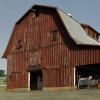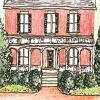Athens Rising
What's Up in New Development

Construction on the Classic Center exhibit hall expansion and atrium, seen here from Foundry Street, is well underway.
Four or five years ago, in late August, a friend texted me, “The masses have descended.” (Insert non-publishable expletives at your discretion.) Those of you who live in Athens year-round or have at least spent a summer here, you know exactly what that text meant. With school starting last week and football season right around the corner, this is the time of year when "island time" in Athens gives way to a faster pace, drunken crowds and awful traffic. Not that I’m complaining. As a University of Georgia alumna and huge football fan, I always look forward to the influx of students and, you guessed it, football season!
If you've been gone, here's what you've missed: Most noticeable to a tailgater like me is the historic North Campus fence, which is undergoing a restoration. The historic cast-iron fence was erected in 1857; all current entrances, including the Arch, originally had gates on them to help keep animals from grazing on campus, except for stairs over the original wooden fence, rather than gates.
UGA restored the fence from the Arch to Jackson Street this summer, and it should be ready in time for the first football game. After football season, the section from the Arch to Lumpkin Street will undergo restoration. The fence was removed section by section, except for three sections where an oak tree has grown into the fence, the crumbling paint was removed and the sections were repainted. The fence is also getting steel interior supports to help make it sturdier and more durable.
The university also restored the Holmes-Hunter Academic Building this summer. The Corinthian columns on the front of the building were stripped to the core and replaced with historically accurate replicas. Replacement rather than repair is a sensitive subject in regard to historic integrity, but, unfortunately, the columns were badly weathered and in disrepair.
Interestingly, the columns are not original to the building. The Holmes-Hunter Academic Building was originally two separate buildings. The structure beside Demosthenian Hall, the Ivy Building (ca. 1831–32), was the first library on campus. The building abutting Broad Street was known as the Old Library (ca. 1859–62). In 1903, the buildings were linked together with the Corinthian colonnade we see today and the façades were altered to create a continuous pattern. In addition to the reconstructed columns, the building received a new paint job this summer. Though not identical to the former paint job, it looks great and makes the building stand out more. It matches well with Candler Hall on Herty Field.
Classes also began at the new Health Sciences Campus this week. The public is invited to attend an open house at 10 a.m., Aug. 22, on the former site of the Navy Supply Corps School on the corner of Prince and Oglethorpe avenues. The two occupants of the new campus are the UGA College of Public Health and UGA's medical school partnership with the newly renamed Georgia Regents University in Augusta, formerly the Medical College of Georgia and Georgia Health Sciences University. Several buildings have already been renovated: five academic buildings, a gym, residences (leased to graduate, medical students and visiting scholars) and the new University Childcare Center (operated by Prodigies Child Care Management). There are future plans for more residence halls, a dining hall and administrative buildings.
While the UGA campus has seen some change in this past year, it’s not the only place around town that's changing. The controversial $24 million expansion of the Classic Center is well underway. The 55,000 square-foot project will nearly double the size of the Classic Center exhibit hall on top of what used to be Hancock Avenue. It also includes a 10,000 square-foot atrium that looks to be modeled after the original Penn Station in New York City that was demolished in 1963. So far, construction has been on schedule, and the new addition is expected to open in March.
Someone has finally decided to reuse the West Broad Street building that formerly housed Red Rooster. (I’m about to show my age here, but I remember when it was Taco Mac.) The building has been sitting empty for several years and, frankly, is an eyesore. The Phi Kappa Tau fraternity will be relocating from their rental house on South Milledge Avenue when the project is finished in about a year.
The fraternity is renovating the building in two phases. The first phase is to turn the existing building into a banquet hall and add a new façade. The second phase will add a residential second story to the building. Though some nearby residents are concerned about the late-night noise a fraternity will produce, the building was formerly a late-night restaurant in an area with several apartment buildings and hotels. The neighborhood is already subjected to a fair amount of late-night noise. (And I would know because I live there.) I, for one, am glad to see the building being reused. Some life needs to be pumped back into that section of Broad Street west of downtown.
And what’s up with Walmart? Things seem to be at a standstill for Selig Enterprises' proposed mixed-use development on the Armstrong & Dobbs property on Oconee Street near downtown. The future of the property remains to be seen.
More by Stella Smith
-

Is the Chain Gang Taking Over Downtown Athens?
Local businesses are closing or moving and chains are taking their place.
-

-

A Historic Garden Is Coming to the Ware-Lyndon House
No one knows what it might have looked like, but they're giving it their best shot.









comments